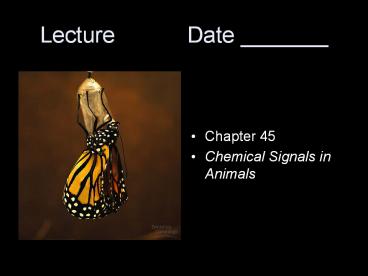LectureDate _______ - PowerPoint PPT Presentation
1 / 16
Title:
LectureDate _______
Description:
Lecture Date _____ Chapter 45 Chemical Signals in Animals Regulatory systems Hormone chemical signal secreted into body fluids (blood) communicating regulatory ... – PowerPoint PPT presentation
Number of Views:60
Avg rating:3.0/5.0
Title: LectureDate _______
1
Lecture Date _______
- Chapter 45
- Chemical Signals in Animals
2
Regulatory systems
- Hormone
- chemical signal secreted into body fluids (blood)
communicating regulatory messages - Target cells
- body cells that respond to hormones
- Endocrine system/glands
- hormone secreting system/glands (ductless)
exocrine glands secrete chemicals (sweat, mucus,
enzymes) through ducts - Neurosecretory cells
- actual cells that secrete hormones
- Feedback mechanisms
- negative and positive
3
Local regulators cells adjacent to or near
point of secretion
- Growth factors
- proteins for cell proliferation
- Nitric oxide (NO)
- neurotransmitter cell destruction vessel
dilation - Prostaglandins
- modified fatty acids secreted by placenta and
immune system also found in semen
4
Mode of Action Chemical Signaling
- 1- Plasma membrane reception
- signal-transduction pathways (neurotransmitters,
growth factors, most hormones) - 2- Cell nucleus reception
- steroid hormones, thyroid hormones, some local
regulators
5
(No Transcript)
6
Vertebrate Endocrine System
- Tropic hormones
- a hormone that has another endocrine gland as a
target - Hypothalamuspituitary
- Pituitary gland
- Pineal gland
- Thyroid gland
- Parathyroid glands
- Thymus
- Adrenal glands
- Pancreas
- Gonads (ovary, testis)
7
(No Transcript)
8
The hypothalamus pituitary, I
- Releasing and inhibiting hormones
- Anterior pituitary
- Growth (GH)bones
- gigantism/dwarfism
- acromegaly
- Prolactin (PRL)mammary glands milk production
- Follicle-stimulating (FSH)
- Luteinizing (LH) ovaries/testes
- Thyroid-stimulating (TSH) thyroid
- Adrenocorticotropic (ACTH) adrenal cortex
- Melanocyte-stimulating (MSH)
- Endorphinsnatural opiates brain pain
receptors
9
The pituitary, II
- The posterior pituitary
- Oxytocin
- uterine and mammary gland cell contraction
- Antidiuretic (ADH)
- retention of water by kidneys
10
The pineal, thyroid, parathyroid
- Melatonin
- pineal gland biological rhythms
- Thyroid hormones
- Calcitonin - lowers blood calcium
- Thyroxine - metabolic processes
- Parathyroid (PTH)
- raises blood calcium
11
(No Transcript)
12
The pancreas
- Islets of Langerhans
- Alpha cells
- Glucagon - raises blood glucose levels
- Beta cells
- Insulin - lowers blood glucose levels
- Type I diabetes mellitus (insulin-dependent
autoimmune disorder) - Type II diabetes mellitus (non-insulin-dependent
reduced responsiveness in insulin targets)
13
(No Transcript)
14
The adrenal glands
- Adrenal medulla (catecholamines)
- epinephrine norepinephrine - increase basal
metabolic rate (blood glucose and pressure) - Adrenal cortex (corticosteroids)
- glucocorticoids (cortisol) - raise blood glucose
- mineralocorticoids (aldosterone) - reabsorption
of Na and K
15
(No Transcript)
16
The gonads
- Steroid hormones precursor is cholesterol
- Androgens (testosterone)
- sperm formation male secondary sex
characteristics gonadotropin - Estrogens (estradiol)
- uterine lining growth female secondary sex
characteristics gonadotropin - Progestins (progesterone)
- uterine lining growth





























